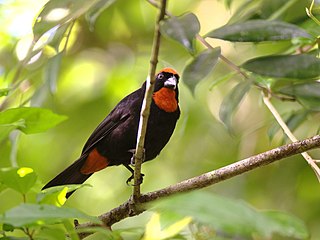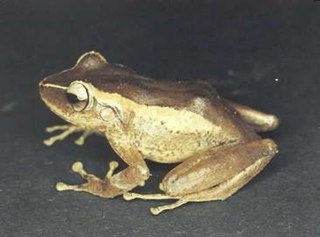
Calliandra is a genus of flowering plants in the pea family, Fabaceae, in the mimosoid clade of the subfamily Caesalpinioideae. It contains about 140 species that are native to tropical and subtropical regions of the Americas.

Alchorneopsis is a genus of flowering plants in the family Euphorbiaceae first described as a genus in 1865. It is native to Central America, the Greater Antilles, and northern South America.
- Alchorneopsis floribunda(Benth.) Müll.Arg. - Costa Rica, Honduras, Panama, Puerto Rico, Dominican Republic, 3 Guianas, Colombia, Venezuela, Ecuador, Peru, NW Brazil
- Alchorneopsis portoricensisUrb. - Puerto Rico

The Puerto Rican spindalis is a bird endemic to the island of Puerto Rico, where it is commonly known as reina mora. The species is widely distributed throughout the island and is an important part of the Puerto Rican ecosystem because of its help in seed dispersal and plant reproduction. The Puerto Rican spindalis has been proposed as the national bird of the United States Commonwealth of Puerto Rico.

The Puerto Rican woodpecker is the only woodpecker endemic to the archipelago of Puerto Rico and is one of the five species of the genus Melanerpes that occur in the Antilles. Furthermore, it is the only resident species of the family Picidae in Puerto Rico. The species is common on the main island of Puerto Rico and rare on the island of Vieques.

The Puerto Rican bullfinch or comeñame in Spanish, is a small bullfinch tanager endemic to the archipelago of Puerto Rico and one of three species belonging to the genus Loxigilla. These were previously considered Emberizidae.

Spindalis is a genus consisting of four non-migratory bird species. The genus is considered endemic to the Greater Antilles; a population on Cozumel Island, off the Yucatán Peninsula's east coast, is part of that island's West Indian fauna. Traditionally considered aberrant tanagers, current studies indicate a different placement.

Eleutherodactylus portoricensis is a frog native to Puerto Rico that belongs to the family Eleutherodactylidae. Its vernacular English names are upland coqui, mountain coqui, and Puerto Rican robber frog. It is found in the Toro Negro State Forest and other similar mountainous regions.

Loxigilla is the genus of Antillean bullfinches, birds in the family Thraupidae. Recent studies have shown it to belong in the tanager family.
The Puerto Rican hutia is an extinct species of rodent in the family Capromyidae. It was found in the Dominican Republic, Haiti, and Puerto Rico.

Styrax portoricensis, locally known as palo de jazmin, is a species of flowering plant in the family Styracaceae. It is endemic to Puerto Rico. It is one of the rarest endemic trees of Puerto Rico and is known to occur only in the northeastern Luquillo Mountains and the north-central Cayey Mountains.

Zamia portoricensis, the marunguey, is a species of plant in the Zamiaceae family. It is endemic to Susua State Forest region of western Puerto Rico.

Crescentia portoricensis is a species of plant in the Bignoniaceae family. It is a perennial evergreen shrub endemic to Puerto Rico. It is threatened by habitat loss. C. portoricensis can grow up to 6 meters and produces a yellowish-white bell shaped flower that ripens into dark green fruits.
Randia portoricensis, known commonly as the Puerto Rico indigoberry, is a species of shrub in the family Rubiaceae. It is endemic to Puerto Rico, and is found in thickets and semi-dry forests.
A. portoricensis may refer to:
C. portoricensis may refer to:
E. portoricensis may refer to:
L. portoricensis may refer to:
M. portoricensis may refer to:











